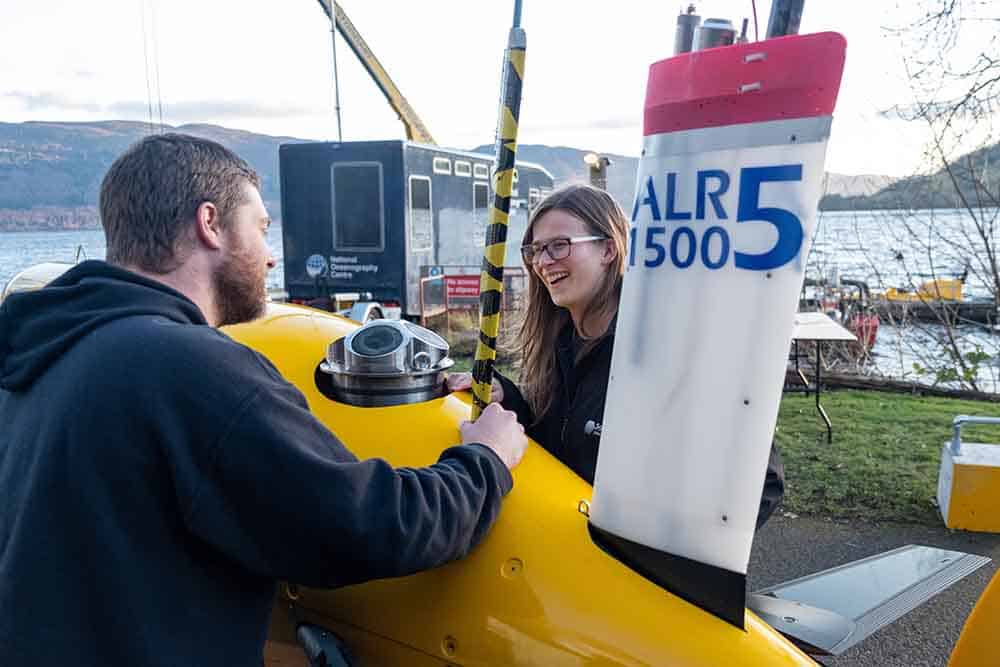New standards in long-endurance underwater navigation and automated subsea positioning have been set following the successful completion of a joint project led by subsea technology specialist Sonardyne International Ltd., with partners the National Oceanography Centre (NOC) and L3Harris.
The two-year, £1.4 million Precise Positioning for Persistent Autonomous Underwater Vehicles (P3AUV) project, part funded by Innovate UK, set out to integrate existing and emerging technologies to deliver a step-change in unmanned platform endurance and navigational precision.
In addition, the project also set out to increase the use of autonomy in offshore survey positioning operations using unmanned surface vessels (USVs), and in the process reducing risk to personnel, environmental impact and operating costs.

The final project trials, which also saw one of the NOC’s largest deployment of AUVs operating in swarms, were completed this month (December) in Loch Ness, Scotland.
“Sending autonomous and unmanned underwater vehicles (AUV/UUVs) out on missions that will last for weeks or even months, unaided by crewed ships is a shared vision held by the ocean science, offshore energy and defence sectors,” says Geraint West, Sonardyne’s Global Business Manager for Ocean Science. “But, current constraints on AUV or UUV operations, such as onboard battery capacity and navigational accuracy degradation over time, has meant that the role these vehicles have had to play has been largely restricted to relatively short deployments.
“As the only company that produces an all-in-one hybrid acoustic-inertial-Doppler navigation and communication solutions for AUVs and USVs, we were uniquely placed to collaborate with the NOC and L3Harris to realise the ambitious aims of the P3AUV project.
[blockquote author=” Geraint West, Sonardyne’s Global Business Manager for Ocean Science”]”By developing and integrating each organisation’s technologies, including our own SPRINT-Nav navigation instrument, we’ve proven it’s possible for underwater platforms to make more of their available onboard power and maintain navigational accuracy over long distances without external aiding.”[/blockquote]
“We’ve also proven the capability to autonomously calibrate networks of seafloor positioning transponders with an L3Harris C-Worker 5 USV to make offshore survey and construction operations faster and easier,” says West.
Using autonomous calibration techniques will remove the need for a manned vessel to perform this task, removing people from harms’ way, driving down fuel emissions and improving efficiencies.
“To put this into perspective, an offshore support or research vessel will typically burn some 3,000 tonnes of fuel annually and generate about 10,000 tonnes (equivalent) of greenhouse gases,” says James Cowles, L3Harris UK. “The environmental footprint of an independent ASV or AUV is, by comparison, negligible.”
“Combining all of these capabilities will bring about a step-change in AUV operations, providing a disruptive capability in the marine autonomy space,” says Matt Kingsland, NOC. “Indeed, reducing the cost and improving the navigation precision of autonomous ocean science in remote areas could bring a disruptive capability to a wide variety of applications.”
Underwater positioning and tracking technology from Sonardyne International Ltd. is to be used to support search and recovery operations undertaken by the Republic of Korea Navy’s (RoKN’s) new auxiliary submarine rescue ship (ASR-II).
Through a contract with GE’s Power Conversion business, the ASR-II will be fitted with Sonardyne’s Ranger 2 Ultra-Short BaseLine (USBL) system. This will interface onboard the vessel with GE’s class leading Seastream™ Dynamic Position (DP) control system providing accurate and fast position reference updates during critical station keeping activities.
The Ranger 2 onboard the ASR-II will also be used to simultaneously track the position of, and communicate with, Sonardyne instrumentation fitted to the new, untethered Deep Search Rescue Vehicle (DSRV) that is being built to operate from the ship when it comes into service.
Ranger 2 is installed on a global fleet of DP vessels operating within defence, offshore energy, ocean research and commercial survey. Its success in meeting the diverse operational requirements of these sectors is built around Sonardyne’s versatile 6G hardware and Wideband 2 signal technology platforms. This combination enables underwater targets to be tracked beyond 11 km, position updates to be acquired every second, and for a vessel to work in any water depth, shallow or deep.
The ASR-II and its moonpool-deployed DSRV are being built under South Korea’s Defense Acquisition Program Administration as a replacement for the submarine rescue ship RoKS Cheonghaejin. The 5,200-tonne ASR-II is expected to be delivered to the RoKN by the end of 2022.
Sonardyne’s order from GE’s Power Conversion business includes everything the ASR-II will need to achieve the best performance from its Ranger 2 USBL during exercises or in the event of a submarine rescue operation. This includes a seabed-deployed 3,000 m-rated Dynamic Positioning Transponder 6 (DPT 6) with recovery floatation collar to provide high accuracy USBL positioning for reliable station keeping, even when operating near sources of potential noise interference such as other naval vessels.
The control room software will be fitted with a Ranger 2 Marine Robotics Pack, which unlocks an additional range of features to enable the vessel crew to both track the DSRV and also communicate with it by sending and receiving status messages.
Finally, Sonardyne will also supply a deployment machine and gate valve, through which the Ranger 2 HPT 5000 USBL transceiver will be deployed through the hull of the ASR-II. The HPT 5000 enables underwater targets to be tracked over a wide range of water depths and elevations so is perfect for vessels needing to undertake different tasks on a regular basis.
[blockquote author=” Derek Lynch, Global Business Manager for Marine Vessel Systems at Sonardyne”]”We have a track record in reliably positioning underwater systems in the deepest waters, as well as shallow water, and for something as critical as a submarine rescue system, you need a system that has proven ability in all situations. Ranger 2 has that. The configuration of equipment we’re supplying to the ASR-II means it will have everything it needs to arrive on site and begin working immediately to support search, rescue and recovery operations anywhere in the world.”[/blockquote]